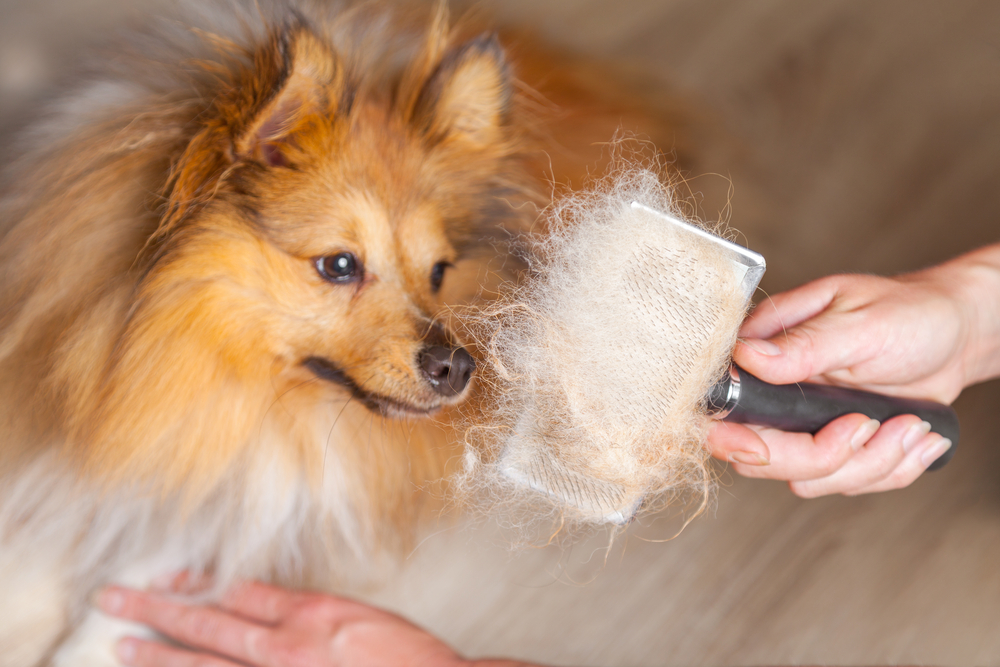Spring Shedding Survival Guide: How Grooming Keeps Your Home Fur-Free

As the seasons shift and warmer weather approaches, pet owners everywhere brace themselves for one of the more challenging aspects of having a furry companion—dog shedding. While shedding is a natural process for most dogs, it seems to intensify during spring and fall. During these transitional seasons, your dog’s coat sheds in response to the changes in temperature, shedding their heavier winter coat in preparation for the lighter, cooler one. This can leave your home blanketed in fur and lead to some frustrating cleaning routines. However, with a proper understanding of dog shedding and a well-planned grooming routine, you can manage the shedding season and keep your home fur-free. Here’s your comprehensive spring shedding survival guide, filled with effective grooming tips for shedding dogs.
The Shedding Cycle
Before diving into how to reduce dog shedding, it’s important to understand the reasons behind it. Shedding is a natural and necessary process for most dogs, helping them maintain a healthy coat that’s suited to the seasons. During winter, dogs grow a thicker coat to insulate them from the cold. When spring arrives, the warmth triggers the shedding of this extra fur to make way for a lighter, cooler coat. The shedding process varies depending on the dog’s breed, health, and environment. Dogs with double coats, like Huskies or Golden Retrievers, often shed the most during seasonal transitions. Some breeds shed all year round, but many will shed more heavily during these times.
Understanding your dog’s unique shedding cycle is key to managing it. For instance, some dogs may shed more heavily in the spring and fall, while others may shed moderately year-round. By recognizing these cycles, you can adjust your grooming routine accordingly to keep the fur under control and reduce the mess in your home.
Essential Grooming Tips for Shedding Dogs
Now that you understand the natural shedding cycle, let’s explore the best ways to keep your dog’s shedding under control during the spring months. Regular dog grooming is the cornerstone of reducing shedding, as it helps remove dead fur before it has a chance to spread all over your house. Here are a few essential grooming tips for shedding dogs that can help:
-
Frequent Brushing: The most effective way to manage shedding is by brushing your dog regularly. Depending on your dog’s coat type, you may need to brush your dog anywhere from once a week to several times a week during peak shedding seasons. For dogs with long or thick coats, use a slicker brush or undercoat rake to reach the underlayer and remove any loose fur. Short-haired dogs can benefit from a rubber curry brush, which helps remove shedding hair without irritating the skin. Brushing not only helps reduce the amount of fur left around the house but also stimulates the skin and promotes a healthy, shiny coat.
-
Bathing: While it’s important not to over-bathe your dog, regular baths can help reduce shedding by loosening dead hair and preventing it from accumulating in your home. Use a dog-specific shampoo that is gentle on their skin and coat. For dogs with thicker coats, a de-shedding shampoo can help remove loose hair and reduce shedding in the long term. It’s also a good idea to use a blow dryer on a low setting to help remove any excess fur after the bath. Keep in mind that bathing your dog too frequently can dry out their skin, so limit baths to every few weeks during shedding season.
-
Use the Right Tools: Not all brushes are created equal, and using the right tool for your dog’s specific coat type can make all the difference in managing shedding. For example, a pin brush is ideal for long-haired dogs, while a deshedding tool like the Furminator is highly effective for double-coated breeds. These tools help to remove the dense undercoat, which is often responsible for the bulk of shedding during spring. Make sure to choose tools that are designed for your dog’s breed and coat type to maximize effectiveness.
-
Nutritional Support: A healthy diet plays an important role in the quality of your dog’s coat. Dogs that are fed a high-quality, well-balanced diet tend to shed less and have healthier coats overall. Look for foods that contain omega-3 fatty acids, which promote a shiny, healthy coat and can reduce excessive shedding. You can also add supplements, like fish oil or flaxseed oil, to help nourish your dog’s skin and coat from the inside out.
-
Regular Vet Checkups: While shedding is natural, excessive shedding could be a sign of an underlying health issue. If your dog is shedding more than usual or if you notice patches of bald spots, it’s a good idea to consult with your veterinarian. Skin allergies, parasites, or even certain illnesses can lead to increased shedding, and a vet can help rule out any medical issues. Regular checkups can also ensure your dog’s skin and coat are in optimal condition.
How to Reduce Dog Shedding in Your Home
While grooming your dog is the most direct way to combat shedding, there are a few additional steps you can take to manage the mess that comes with it. With these tips, you’ll keep your home cleaner during the shedding season:
-
Vacuum Regularly: Even with all the grooming in the world, it’s impossible to eliminate shedding entirely. To reduce the amount of hair in your home, make sure to vacuum frequently—ideally, a few times a week during shedding season. A vacuum with a pet-specific attachment can help you pick up even the smallest bits of fur from carpets and upholstery. Don’t forget to vacuum your furniture, including couches and chairs, as dog hair can easily cling to fabric.
-
Use Furniture Covers: If your dog loves lounging on the couch or bed, using washable furniture covers can save you a lot of time and frustration. These covers are easy to remove and clean, so you can quickly get rid of any fur that your dog sheds on these surfaces. You can also invest in pet-friendly furniture that is easier to clean, such as leather or faux leather, which don’t trap as much hair.
-
Lint Rollers and Pet Hair Removers: Lint rollers are an effective way to remove pet hair from clothing and smaller surfaces. Keep a lint roller in strategic places around the house, such as by the door or in your car, so you can quickly remove fur before it gets too out of hand. There are also specialized pet hair removal brushes that work on both clothing and furniture, making them a great tool to have on hand.
-
Keep Your Dog Off Certain Areas: If your dog tends to shed a lot, you might want to limit their access to certain rooms in your home, such as the bedroom or dining room. Setting boundaries will help reduce the amount of hair accumulating in these spaces, making it easier to maintain a clean home. You can also set up designated areas for your dog to rest, such as a cozy bed or a crate, where the shedding can be more easily controlled.
-
Air Purifiers: Investing in a good air purifier with a HEPA filter can help remove pet dander and hair from the air, especially in rooms where your dog spends the most time. This will help reduce the spread of allergens and pet hair that can settle on furniture, clothing, and floors.
Seasonal Dog Grooming: Beyond Shedding
While spring shedding is often the most noticeable, it’s important to remember that seasonal dog grooming involves more than just managing fur. As the weather warms up, there are other grooming tasks to keep in mind for your dog’s health and comfort. These tasks should be part of your regular grooming routine:
-
Ear Cleaning: Warmer weather can increase the likelihood of ear infections, especially for dogs with floppy ears. Regular ear cleaning can help prevent issues. Use a vet-recommended ear cleaner and a cotton ball to gently wipe the inside of your dog’s ears, removing dirt and wax build-up.
-
Nail Trimming: Spring is a great time to check your dog’s nails and trim them if needed. Long nails can cause discomfort and lead to other health issues. Regular trims will keep your dog comfortable during outdoor activities and ensure they don’t damage your floors or furniture.
-
Parasite Protection: With the warmer weather comes an increase in fleas, ticks, and other parasites. Ensure your dog is on a flea and tick preventative plan. Regular grooming, including a thorough check of your dog’s coat and skin, can help you spot these pests early and address them before they become a problem.
By following these grooming tips and maintaining a consistent routine, you can ensure your dog stays comfortable during the shedding season, and your home remains as fur-free as possible. Seasonal dog grooming isn’t just about reducing the mess; it’s about promoting your dog’s overall health and well-being. With a little time and effort, you can enjoy a fur-free home while keeping your dog happy and healthy all season long.
Need Dog Services Near You?
At Just Four Paws, Inc., we understand that your furry friends are more than just pets – they are cherished members of your family. That’s why we are committed to providing the best possible care for them during their stay with us. Our pet boarding services offer a safe and comfortable environment where your pets will receive individual attention and plenty of playtime. Additionally, our expert groomers are dedicated to pampering your pets and ensuring they look and feel their best. Trust Just Four Paws, Inc. with your pets’ needs and give them the love and care they deserve. Contact us today to learn more about what we can do for you!
